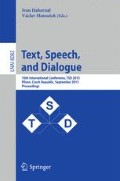Abstract
Almost all current spoken dialog systems treat dialog as that where a single user talks to an agent. On the other hand, we set out to investigate a multiparty dialog system that deals with two agents and a single user. We developed a three person (one user and two agents) and a two person (one user and one agent) dialog system to consider the same dialog tasks, that is, “Which do you prefer, udon or ramen (Japanese noodle or Chinese noodle)?” and ‘Which do you want to travel to Hokkaido or Okinawa (snowy region or tropical region)?” and compared them with respect to user behavior and satisfaction. According to the results of the experiments, the three person dialog system performed better in terms of lively conversation, and user can talk with the agents more like chatting.
Access this chapter
Tax calculation will be finalised at checkout
Purchases are for personal use only
Preview
Unable to display preview. Download preview PDF.
References
Nishimura, R., Nakagawa, S.: Response timing generation and response type selection for a spontaneous spoken dialog system. In: Proceedings of 2009 IEEE Workshop on ASRU 2009, pp. 462–467 (2009)
Itoh, T., Kitaoka, N., Nishimura, R.: Subjective experiments on influence of response timing in spoken dialogues. In: Proceedings of the Interspeech 2009, pp. 1835–1838 (2009)
Dielmann: DBN Based Joint Dialogue Act Recognition of Multiparty Meetings. In: Proceedings of ICASSP 2007, pp. 133–136 (2007)
Shriberg, E., Stolcke, A., Baron, D.: Observations on Overlap: Findings and Implications for Automatic Processing of Multi-Party Conversation. In: Proceedings of the Interspeech 2009, pp. 1359–1362 (2009)
Klotz, D., et al.: Engagement-based Multi-party Dialog with a Humanoid Robot. In: SIGDIAL Conference 2011, pp. 341–343 (2011)
Fujie, S., Kobayashi, T., et al.: Conversation Robot Participating in and Activating a Group Communication. In: Proceedings of the Interspeech 2009, pp. 264–267 (2009)
Swartout, W., et al.: Ada and Grace: Toward Realistic and Engaging Virtual Museum Guides. In: Allbeck, J., Badler, N., Bickmore, T., Pelachaud, C., Safonova, A. (eds.) IVA 2010. LNCS (LNAI), vol. 6356, pp. 286–300. Springer, Heidelberg (2010)
Traum, D., Marsella, S.C., Gratch, J., Lee, J., Hartholt, A.: Multi-party, Multi-issue, Multi-strategy Negotiation for Multi-modal Virtual Agents. In: Prendinger, H., Lester, J.C., Ishizuka, M. (eds.) IVA 2008. LNCS (LNAI), vol. 5208, pp. 117–130. Springer, Heidelberg (2008)
Dohsaka, K., Asai, R.: Effects of Conversational Agents on Human Communication in Thought-Evoking Multi-Party Dialogues. In: SIGDIAL, pp. 217–224 (2009)
Kai, A., Nakagawa, S.: A frame-synchronous continuous speech recognition algorithm using a top-down parsing of context-free grammar. In: ICSLP, pp. 257–260 (1992)
Kawamoto, S., Shimodaira, H., Sagayama, S.: Open-source software for developing anthropomorphic spoken dialog agent. In: Proc. of PRICAI 2002, International Workshop on Lifelike Animated Agents, pp. 64–69 (2002)
Open JTalk, http://open-jtalk.sourceforge.net/
Author information
Authors and Affiliations
Editor information
Editors and Affiliations
Rights and permissions
Copyright information
© 2013 Springer-Verlag Berlin Heidelberg
About this paper
Cite this paper
Todo, Y., Nishimura, R., Yamamoto, K., Nakagawa, S. (2013). Development and Evaluation of Spoken Dialog Systems with One or Two Agents through Two Domains. In: Habernal, I., Matoušek, V. (eds) Text, Speech, and Dialogue. TSD 2013. Lecture Notes in Computer Science(), vol 8082. Springer, Berlin, Heidelberg. https://doi.org/10.1007/978-3-642-40585-3_24
Download citation
DOI: https://doi.org/10.1007/978-3-642-40585-3_24
Publisher Name: Springer, Berlin, Heidelberg
Print ISBN: 978-3-642-40584-6
Online ISBN: 978-3-642-40585-3
eBook Packages: Computer ScienceComputer Science (R0)

